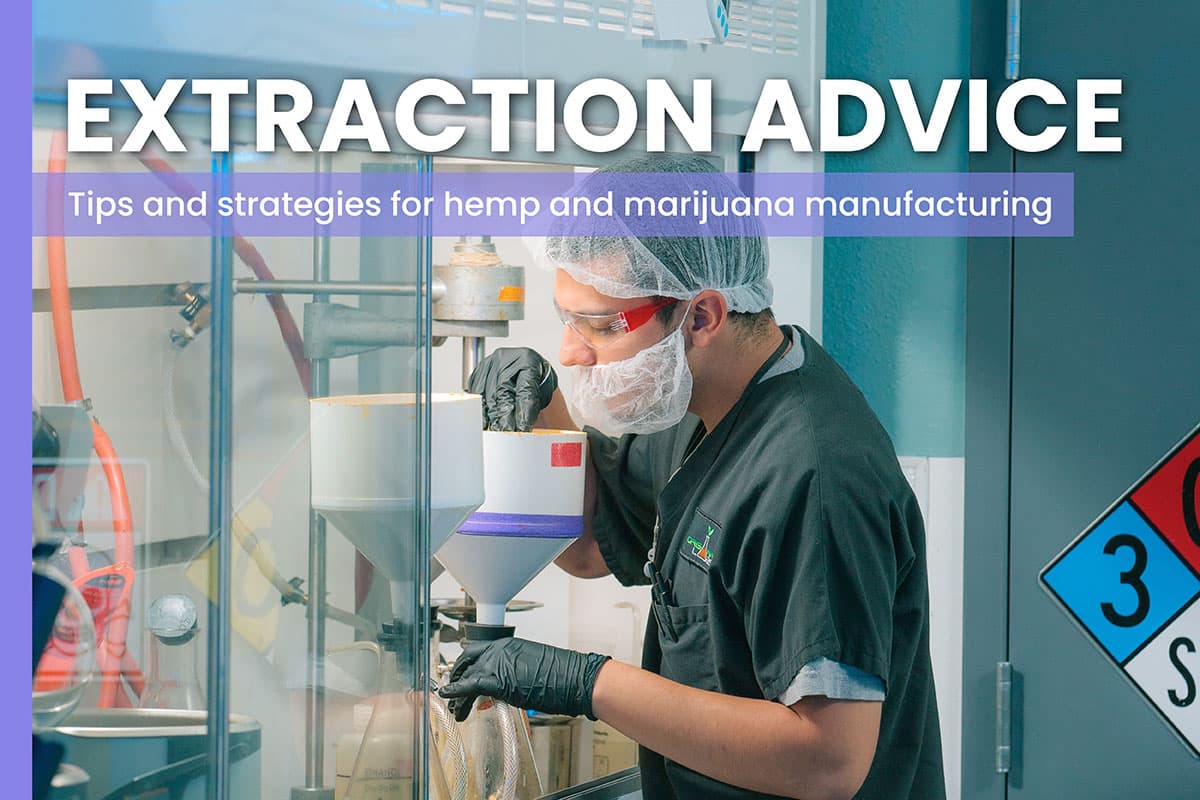(This is the first installment in an ongoing series offering tips and advice for marijuana and hemp extraction companies.)
For cannabis extraction companies, becoming more efficient and more productive goes hand in hand with expansion and scaling up.
Marijuana extraction firms looking to cut costs and boost efficiencies can do so in several ways, including:
- Adding automated solutions to extraction equipment.
- Sourcing high-quality starting material.
- Designing the facility to streamline the process and improve workflow.
Automation
Automating certain parts of the extraction process can dramatically reduce labor costs and increase throughput time.
At Copperstate Farms, a vertically integrated cannabis company in Snowflake, Arizona, Director of Extraction Zach Brown is using ethanol to produce bulk distillate.
The company is in the process of purchasing automation solutions for the extraction, filtration, solvent recovery and decarboxylation steps in the process.
“I anticipate as the industry continues to grow, automation will become more and more crucial,” Brown said.
For example, instead of using manually operated valves in the flow path, he’s added sensors and solenoid valves that decrease the amount of labor.
“Distillate is easy to scale and automate,” Brown said.
Aside from the labor saved with the technology, it creates a smooth workflow, avoiding making workers carry material from one stage to the next.
For instance, instead of having an employee haul a vat of extracted oil to the filtration system, it will be pumped over. This also cuts down on product loss from residual buildup in separate containers.
It reduces workers’ compensation issues caused by repetitive-use injuries, too.
Brown said it should take the company about three to six months to recover the cost of the investment in automation.
At High Life Farms, a vertically integrated cannabis company in Chesaning, Michigan, Extraction Manager Connor Schilling is also using automation to achieve efficiencies and quickly make distillate.
“Speed is of the most importance,” he said.
Schilling said some extractors winterize their material by hand, then take that solution, put it into an evaporator and move on to the next step.
“That’s clunky,” he said. “Adding automation and doing as many processes in one machine is going to be the most beneficial for you.”
Using a more automated system can save multiple days by cutting out all that transfer time, according to Schilling.
Starting material
Quality in, quality out, as the saying goes.
Vertically integrated cannabis companies that grow flower for extraction have an advantage here.
In particular, companies making solvent-free extracts that are designed to replicate the whole-plant experience, including full terpene profiles.
“Starting material is paramount in a solventless lab,” said Thilo Savage, project manager for production and cultivation at Lume, a Troy, Michigan-based cannabis company making solvent-free extraction products.
“Ideally, plants are grown from scratch with the specific purpose of being transformed into solventless products.”
Joel Ruggiero, chief horticulture officer for vertically integrated cannabis company C3 Industries, wants his biomass to be highly potent and clean.
At the facility he runs in Portland, Oregon, good starting material means a much more efficient process.
By “good,” he means not a lot of debris – sticks and stems – to sort out. He prefers to work only with flower buds, shake and trim.
“Low-end product slows down your process,” Ruggiero said.
Poor biomass also means it could need to be run through extraction two or three times to be refined enough to be market-ready.
Aaron Nino, director of production for Las Vegas-based Camp, agreed that the starting material is crucial. His company grows flower specifically for its in-house, solventless extraction products.
If his cultivation team can grow great flower with high potency and a robust terpene profile, then his extracted product will be all the better for it.
Plus, great starting material can mean he’ll get up to three products from one batch of flower – dry sift, crude oil and Rick Simpson Oil.
“That’s how you can make solventless extraction efficient,” Nino said.
Facility design
A correctly designed facility allows a company to not only run an efficient process now but also in the future as the company scales up.
At C3 Industries, the lab is designed to be part of the cultivation facility.
That way, flower flows directly to the extraction lab.
For example, fresh frozen material goes directly to processing with no downtime or product degradation.
“It’s a quick, easy, streamlined operation,” Ruggiero said.
Savage recommends designing an extraction lab with both current and future throughput in mind.
For example, if a power load is arranged to accommodate only one freeze dryer – because only one is needed for the current workload – what happens when your business expands and you need a second freeze dryer to meet demand?
It would have to be placed in a different room and plugged into a separate breaker.
While that might seem like a minor bump in the road, this disorganized setup will disrupt workflow.
“Scalability must be incorporated into every piece of the design to avoid operational inefficiencies down the road,” Savage said.
Flexibility is also important, according to Savage. Deviations in strains and starting material can cause unforeseen bottlenecks.
“By building a lab with the capacity to run multiple batches concurrently,” he added, “you avoid the need to pause operations to clean and maintain equipment.”
Bart Schaneman can be reached at [email protected].
Medical Disclaimer:
The information provided in these blog posts is intended for general informational and educational purposes only. It is not a substitute for professional medical advice, diagnosis, or treatment. Always seek the advice of your physician or other qualified healthcare provider with any questions you may have regarding a medical condition. The use of any information provided in these blog posts is solely at your own risk. The authors and the website do not recommend or endorse any specific products, treatments, or procedures mentioned. Reliance on any information in these blog posts is solely at your own discretion.






